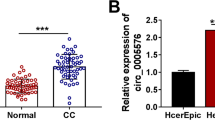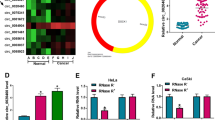Abstract
It is well established that circular RNAs (circRNAs) play a role in tumor initiation and tumorigenesis. The goal of this study was to reveal the detailed functions and regulatory mechanisms of circ_0000078 in cervical cancer (CC). Circ_0000078, miR-205-5p, and epiregulin (EREG) mRNA expression levels were examined using RT-qPCR. Western blotting was performed to quantify EREG protein. Cell proliferation, apoptosis, migration, and invasion were examined by performing CCK-8, caspase 3 activity, wound healing, and transwell assays, respectively. The effect of circ_0000078 on tumor growth in vivo was confirmed in a xenograft model. The putative relationship between miR-205-5p and circ_0000078 or EREG, as predicted by bioinformatics analysis, was evaluated by dual-luciferase and RNA immunoprecipitation assays. Aberrant downregulation of circ_0000078 and EREG as well as upregulation of miR-205-5p were observed in cervical tumor samples and cancer cells. Ectopic expression of circ _0000078 not only restrained cancer cell growth, survival, migration, and invasiveness, but also decelerated tumor formation and development in a mouse model. miR-205-5p, acts as a target of circ_0000078 and directly binds to EREG to repress its expression. Overexpression of miR-205-5p reversed the inhibitory effects of circ_0000078 upregulation on cancer cell behavior and also partially abolished the anti-cancer effects of EREG upregulation in vitro. Circ_0000078 inhibits the growth of cancer by interfering with the miR-205-5p/EREG network, acting as a tumor suppressor in CC. These results provide a better understanding of the pathogenesis of this disease.






Similar content being viewed by others
Data Availability
All data generated or analyzed during this study are included in this article.
References
Sung, H., Ferlay, J., Siegel, R. L., Laversanne, M., Soerjomataram, I., Jemal, A., et al. (2021). Global Cancer Statistics 2020: GLOBOCAN estimates of incidence and mortality worldwide for 36 cancers in 185 countries. CA: A Cancer Journal for Clinicians, 71(3), 209–249.
Hillemanns, P., Soergel, P., Hertel, H., & Jentschke, M. (2016). Epidemiology and early detection of cervical cancer. Oncology Research and Treatment, 39(9), 501–506.
Gardner, A. B., Charo, L. M., Mann, A. K., Kapp, D. S., Eskander, R. N., & Chan, J. K. (2020). Ovarian, uterine, and cervical cancer patients with distant metastases at diagnosis: Most common locations and outcomes. Clinical & Experimental Metastasis, 37(1), 107–113.
Ward, Z. J., Grover, S., Scott, A. M., Woo, S., Salama, D. H., Jones, E. C., et al. (2020). The role and contribution of treatment and imaging modalities in global cervical cancer management: Survival estimates from a simulation-based analysis. The Lancet Oncology, 21(8), 1089–1098.
Salzman, J., Gawad, C., Wang, P. L., Lacayo, N., & Brown, P. O. (2012). Circular RNAs are the predominant transcript isoform from hundreds of human genes in diverse cell types. PLoS ONE, 7(2), e30733.
Salzman, J. (2016). Circular RNA expression: Its potential regulation and function. Trends in Genetics, 32(5), 309–316.
Wang, W., Wang, Y., Piao, H., Li, B., Huang, M., Zhu, Z., et al. (2019). Circular RNAs as potential biomarkers and therapeutics for cardiovascular disease. PeerJ, 7, e6831.
Saaoud, F., Drummer, I. V. C., Shao, Y., Sun, Y., Lu, Y., Xu, K., et al. (2021). Circular RNAs are a novel type of non-coding RNAs in ROS regulation, cardiovascular metabolic inflammations and cancers. Pharmacology & Therapeutics, 220, 107715.
Chaichian, S., Shafabakhsh, R., Mirhashemi, S. M., Moazzami, B., & Asemi, Z. (2020). Circular RNAs: A novel biomarker for cervical cancer. Journal of Cellular Physiology, 235(2), 718–724.
Tang, X., Wen, X., Li, Z., Wen, D., Lin, L., Liu, J., et al. (2021). Hsa_circ_0102171 aggravates the progression of cervical cancer through targeting miR-4465/CREBRF axis. Journal of Cellular Physiology, 236(7), 4973–4984.
Cen, Y., Zhu, T., Zhang, Y., Zhao, L., Zhu, J., Wang, L., et al. (2022). hsa_circ_0005358 suppresses cervical cancer metastasis by interacting with PTBP1 protein to destabilize CDCP1 mRNA. Molecular Therapy Nucleic Acids, 27, 227–240.
Zhang, C., Liu, P., Huang, J., Liao, Y., Pan, C., Liu, J., et al. (2021). Circular RNA hsa_circ_0043280 inhibits cervical cancer tumor growth and metastasis via miR-203a-3p/PAQR3 axis. Cell Death & Disease, 12(10), 888.
De Cola, A., Lamolinara, A., Lanuti, P., Rossi, C., Iezzi, M., Marchisio, M., et al. (2018). MiR-205-5p inhibition by locked nucleic acids impairs metastatic potential of breast cancer cells. Cell Death & Disease, 9(8), 821.
Wang, Y., Zhang, Z., Tao, P., Reyila, M., Qi, X., & Yang, J. (2020). The abnormal expression of miR-205-5p, miR-195-5p, and VEGF-A in human cervical cancer is related to the treatment of venous thromboembolism. BioMed Research International, 2020, 3929435.
Shi, X., Xiao, L., Mao, X., He, J., Ding, Y., Huang, J., et al. (2018). miR-205-5p mediated downregulation of PTEN contributes to cisplatin resistance in C13K human ovarian cancer cells. Frontiers in Genetics, 9, 555.
Lin, C. Y., Hsieh, P. L., Chou, C. L., Yang, C. C., Lee, S. W., Tian, Y. F., et al. (2020). High EREG expression is predictive of better outcomes in rectal cancer patients receiving neoadjuvant concurrent chemoradiotherapy. Oncology, 98(8), 549–557.
He, M., Jin, Q., Chen, C., Liu, Y., Ye, X., Jiang, Y., et al. (2019). The miR-186-3p/EREG axis orchestrates tamoxifen resistance and aerobic glycolysis in breast cancer cells. Oncogene, 38(28), 5551–5565.
Chen, S., Yue, T., Huang, Z., Zhu, J., Bu, D., Wang, X., et al. (2019). Inhibition of hydrogen sulfide synthesis reverses acquired resistance to 5-FU through miR-215-5p-EREG/TYMS axis in colon cancer cells. Cancer Letters, 466, 49–60.
Livak, K. J., & Schmittgen, T. D. (2001). Analysis of relative gene expression data using real-time quantitative PCR and the 2(-Delta Delta C(T)) method. Methods, 25(4), 402–408.
Jiao, J., Zhang, T., Jiao, X., Huang, T., Zhao, L., Ma, D., et al. (2020). hsa_circ_0000745 promotes cervical cancer by increasing cell proliferation, migration, and invasion. Journal of Cellular Physiology, 235(2), 1287–1295.
Shao, R., Bao, S., Bai, X., Blanchette, C., Anderson, R. M., Dang, T., et al. (2004). Acquired expression of periostin by human breast cancers promotes tumor angiogenesis through up-regulation of vascular endothelial growth factor receptor 2 expression. Molecular and Cellular Biology, 24(9), 3992–4003.
Jeyaraman, S., Hanif, E. A. M., Ab Mutalib, N. S., Jamal, R., & Abu, N. (2019). Circular RNAs: Potential regulators of treatment resistance in human cancers. Frontiers in Genetics, 10, 1369.
Li, S., Teng, S., Xu, J., Su, G., Zhang, Y., Zhao, J., et al. (2019). Microarray is an efficient tool for circRNA profiling. Briefings in Bioinformatics, 20(4), 1420–1433.
Zheng, Q., Zhang, J., Zhang, T., Liu, Y., Du, X., Dai, X., et al. (2021). Hsa_circ_0000520 overexpression increases CDK2 expression via miR-1296 to facilitate cervical cancer cell proliferation. Journal of Translational Medicine, 19(1), 314.
Zhong, P., Guo, A., Wang, L., Lin, X., & Feng, M. (2022). Circular RNA CDK6 suppresses cervical cancer proliferation and metastasis by sponging miR-449a. Bioengineered, 13(3), 4885–4897.
Liao, W., He, J., Disoma, C., Hu, Y., Li, J., Chen, G., et al. (2020). Hsa_circ_0107593 suppresses the progression of cervical cancer via sponging hsa-miR-20a-5p/93-5p/106b-5p. Frontiers in Oncology, 10, 590627.
Zhang, J., Zhang, J., Pang, X., Chen, Z., Zhang, Z., Lei, L., et al. (2021). MiR-205-5p suppresses angiogenesis in gastric cancer by downregulating the expression of VEGFA and FGF1. Experimental Cell Research, 404(2), 112579.
Yamada, Y., Nishikawa, R., Kato, M., Okato, A., Arai, T., Kojima, S., et al. (2018). Regulation of HMGB3 by antitumor miR-205-5p inhibits cancer cell aggressiveness and is involved in prostate cancer pathogenesis. Journal of Human Genetics, 63(2), 195–205.
Zhang, G. F., Wu, J. C., Wang, H. Y., Jiang, W. D., & Qiu, L. (2020). Overexpression of microRNA-205–5p exerts suppressive effects on stem cell drug resistance in gallbladder cancer by down-regulating PRKCE. Bioscience Reports. https://doi.org/10.1042/BSR20194509
Lu, Z., Xu, Y., Yao, Y., & Jiang, S. (2019). miR-205–5p contributes to paclitaxel resistance and progression of endometrial cancer by downregulating FOXO1. Oncology Research. https://doi.org/10.3727/096504018X15452187888839
Wang, W., Yin, Y., Shan, X., Zhou, X., Liu, P., Cao, Q., et al. (2019). The Value of plasma-based microRNAs as diagnostic biomarkers for ovarian cancer. The American Journal of the Medical Sciences, 358(4), 256–267.
Niu, Z., Wang, F., Lv, S., Lv, Y., Liu, M., Fu, L., et al. (2021). HNRNPU-AS1 regulates cell proliferation and apoptosis via the microRNA 205–5p/AXIN2 axis and Wnt/β-catenin signaling pathway in cervical cancer. Molecular and Cellular Biology, 41(10), e0011521.
Cheng, W. L., Feng, P. H., Lee, K. Y., Chen, K. Y., Sun, W. L., Van Hiep, N., et al. (2021). The role of EREG/EGFR pathway in tumor progression. International Journal of Molecular Sciences, 22(23), 12828.
Wang, Y., Jing, Y., Ding, L., Zhang, X., Song, Y., Chen, S., et al. (2019). Epiregulin reprograms cancer-associated fibroblasts and facilitates oral squamous cell carcinoma invasion via JAK2-STAT3 pathway. Journal of Experimental & Clinical Cancer Research : CR, 38(1), 274.
Zong, S., Liu, X., Zhou, N., & Yue, Y. (2019). E2F7, EREG, miR-451a and miR-106b-5p are associated with the cervical cancer development. Archives of Gynecology and Obstetrics, 299(4), 1089–1098.
Acknowledgements
None.
Funding
This work was supported by 2021 Wuhan Municipal Health Commission scientific research projects: Western medicine and public health "RGD-USPIO targeted nano-contrast agent 4.7T MRI in vivo scanning molecular imaging in precise definition of cervical cancer radiotherapy target", Grant Number: WX21C28.
Author information
Authors and Affiliations
Contributions
CL conducted the experiments and data analysis. CL and YL designed this study and formed the methodology. CL did investigation. YL wrote the paper. This manuscript was reviewed and revised by CL. This work has been reviewed and approved by all authors.
Corresponding author
Ethics declarations
Conflict of interest
The authors affirm that they do not have any competing interests.
Ethical Approval
The present study was approved by the Ethics Committee of our hospital. The Declaration of Helsinki's ethical guidelines are strictly followed when processing clinical tissue samples. Each patient completed an informed consent form in writing. This animal experiment was conducted in accordance with the ARRIVE guidelines and was authorized by the Ethics Committee of our hospital.
Informed Consent
Each patient completed an informed consent form in writing.
Consent for Publication
Consent for publication was obtained from the participants.
Additional information
Publisher's Note
Springer Nature remains neutral with regard to jurisdictional claims in published maps and institutional affiliations.
Rights and permissions
Springer Nature or its licensor (e.g. a society or other partner) holds exclusive rights to this article under a publishing agreement with the author(s) or other rightsholder(s); author self-archiving of the accepted manuscript version of this article is solely governed by the terms of such publishing agreement and applicable law.
About this article
Cite this article
Liu, C., Li, Y. Hsa_circ_0000078 Regulates miR-205-5p/EREG Pathway to Inhibit Cervical Cancer Progression. Mol Biotechnol 65, 1453–1464 (2023). https://doi.org/10.1007/s12033-023-00658-6
Received:
Accepted:
Published:
Issue Date:
DOI: https://doi.org/10.1007/s12033-023-00658-6




